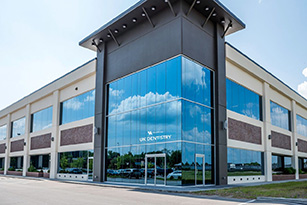VISION THING: Dr. Marcus F. Abboud, Kentucky’s associate dean of digital dentistry, in the school’s design laboratory
The University of Kentucky aims to become a global leader in high-tech digital dentistry. Here’s how.
BY MELANIE BAVARIA
IT WAS A VERY big deal in Lexington, Kentucky, when the gleaming UK HealthCare at Turfland clinic opened its doors in April 2015. It was an especially proud occasion for the University of Kentucky College of Dentistry, whose newly consolidated departments would now be far patient-friendlier than before.
Fittingly, Turfland is home to the university’s “digital-dentistry initiative,” a headlong effort to make UK Dental a byword for the absolute latest in digital technology and treatment. The project is spearheaded by Dr. Marcus F. Abboud, UK’s associate dean of digital dentistry, who sat down with Incisal Edge to discuss dental technology’s bold new frontiers.
How are you implementing UK’s digital-dentistry initiative?
The new facility, the Turfland clinic, operates like a faculty practice. The dean [Dr. Stephanos Kyrkanides] really wanted a state-of-the-art center to show what’s possible with digital today. So Turfland can diagnose pretty much everything you can do with digital: CBCT scans, laser face scanners that show you the aesthetic result of your new crown.
We can plan and manufacture everything, from surgical guides to high-end implant restorations. I’m not aware of any university in the United States right now that can do that. Not even every dental lab can do this, and only a few medical manufacturers are.
How will this change the patient experience?
It changes everything. We’re striving for single visits. We’re saying, “Come to our facility at 8 in the morning. We’ll run full diagnostics and full planning, and you’re leaving at 4 or 5 the same afternoon fully restored,” no matter what we have to do — whether it’s a single small filling or eight implants in the maxilla.
“Our treatment approach is simpler and smarter, to make it easy for the patient to get as comfortable as possible. So instead of coming in 10 times, you come one time.”
If you get just a single crown, normally you have two or three patient visits. We can do it in one. You come in, the student does the diagnostics — we plan it together with the student — and the same afternoon we insert the crown. Then you go home and you don’t need to come back.
Why is this aspect of treatment so important?
What the patient wants is a brilliant smile. They want to go back to their social life without any compromises. It’s not fun when a tooth is missing and you can’t speak properly. It doesn’t look nice. When a patient today gets an implant treatment, you have a healing period of three months, during which you’re wearing a provisional prosthesis that you have to take out in the evening and clean.
It doesn’t hold up well; you can’t really chew or speak with it.
Our treatment approach is simpler and smarter, to make it easy for the patient to get as comfortable as possible. So instead of coming in 10 times, you come one time. This is what digital can do: It simplifies everything. And the redo rate is going way down.
Take us through the process. Let’s use implants as an example.
We start on the computer, completely digital. And [the patient] can look at it — I can show you a smile with it, you can change and alter everything with us on the computer screen. When we have the final position of your teeth, we plan the implants according to that position.
Then I use a computer-assisted navigation system and a 3D printer to produce a surgical guide, and the implant position is exactly where I planned it. So now, my provisional
that I manufactured before I placed the implants fits perfectly. Then I mill them. Everything is done with CAD/CAM technology, everything digitally — and your provision is lying on the table before a single implant is placed. It’s a world of difference.
How are you training UK Dental’s faculty to use all these new machines?
We do regular training sessions for the faculty. We also have scanners and other equipment for faculty to use with their own patients so they can get experience with the technology. It’s an ongoing process.
What effect will all this have on the curriculum in the years ahead?
We’re starting in [students’] year two or year one, even. So as a freshman, you’re already getting exposed to the technology. By the time you’re in clinic, you’ll be fully competent in it. The University of Kentucky understands that digital technology is one of the most important things changing the practice of dentistry for the next
20 years. We’re investing to be at the forefront of it.

What’s the killer app that sets UK Dental and Turfland apart?
We have all specialties under one roof. The surgeon is placing the implants, and the restorative dentist is in the next room. A regular dentist can’t normally offer that. Even bigger offices with multiple specialties don’t always have the resources to invest in this technology, which is really expensive. We have multiple milling machines, multiple scanners. The technology is available, but it’s rare that an institution puts it all together.
Given the expense, can it be cost-effective for the university?
Absolutely, because there’s a lot of demand for it. Patients want to have smiles. They want to be able to speak. And we give them that, right away.



